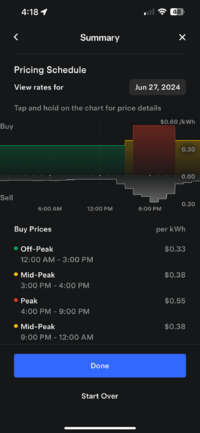NEM3.0 Time-Of-Use Electric Home E-ELEC
This is what I was afraid of, it’s off peak time and I’m using the air conditioner needing more than solar is generating and instead of using the power wall, it’s taking it from the grid.
I was pretty sure based on what people said that the very most PG&E will pay me since I’m brand new to this and on the worst version of it is four cents or I don’t know maybe eight cents per kW but at no time will anything I buy from them be less than what they pay me, right?
I know I can change it to self powered and stop it from happening, but the Tesla person yesterday guaranteed me that I would not take from the grid when I had power wall capability and that’s exactly what is happening. Anyone have experience with to tell me what’s happening, thanks?
He also said if I switch back and forth from self power to time-based control that the time-based control has to relearn everything that takes a couple of days is that sound right to everybody?
The other thing that confused me was, he said if I’m on self powered, I will not ever sell to PG&E, that when self powered. I’m unable to export to them, I had not known that that’s annoying.
And I’ll look this one up, but I don’t know if sell price is what I get when I sell it to them and buy price is what I pay them or in reverse. I don’t know.
If I am right that at no time will they pay me more than I pay them for a kilowatt then I would like for it to be set up that I export to them or whatever but I never used the grid unless my power wall is below the reserve amount. And I just looked at the graph and at no point during the 24 hours is the sell anywhere near as high as the Buy.
Do you only get charged for the amount from the grid that you’ve used that’s in excess of what you exported to them? The only way this makes sense is since I’m being paid eight cents and I have to pay them $.40 per kilowatt if I don’t pay for kilowatts other than those that exceed the amount I’ve sold to them in that day. Does that make sense? Do you understand what I’m saying in that having nothing to do with the cost of the kilowatt if I export 9 kW today and I import 8kW then I don’t pay for any of those eight regardless of what they cost and regardless of what they would pay me for those nine is that possible?
This is what I was afraid of, it’s off peak time and I’m using the air conditioner needing more than solar is generating and instead of using the power wall, it’s taking it from the grid.
I was pretty sure based on what people said that the very most PG&E will pay me since I’m brand new to this and on the worst version of it is four cents or I don’t know maybe eight cents per kW but at no time will anything I buy from them be less than what they pay me, right?
I know I can change it to self powered and stop it from happening, but the Tesla person yesterday guaranteed me that I would not take from the grid when I had power wall capability and that’s exactly what is happening. Anyone have experience with to tell me what’s happening, thanks?
He also said if I switch back and forth from self power to time-based control that the time-based control has to relearn everything that takes a couple of days is that sound right to everybody?
The other thing that confused me was, he said if I’m on self powered, I will not ever sell to PG&E, that when self powered. I’m unable to export to them, I had not known that that’s annoying.
And I’ll look this one up, but I don’t know if sell price is what I get when I sell it to them and buy price is what I pay them or in reverse. I don’t know.
If I am right that at no time will they pay me more than I pay them for a kilowatt then I would like for it to be set up that I export to them or whatever but I never used the grid unless my power wall is below the reserve amount. And I just looked at the graph and at no point during the 24 hours is the sell anywhere near as high as the Buy.
Do you only get charged for the amount from the grid that you’ve used that’s in excess of what you exported to them? The only way this makes sense is since I’m being paid eight cents and I have to pay them $.40 per kilowatt if I don’t pay for kilowatts other than those that exceed the amount I’ve sold to them in that day. Does that make sense? Do you understand what I’m saying in that having nothing to do with the cost of the kilowatt if I export 9 kW today and I import 8kW then I don’t pay for any of those eight regardless of what they cost and regardless of what they would pay me for those nine is that possible?
Last edited:



